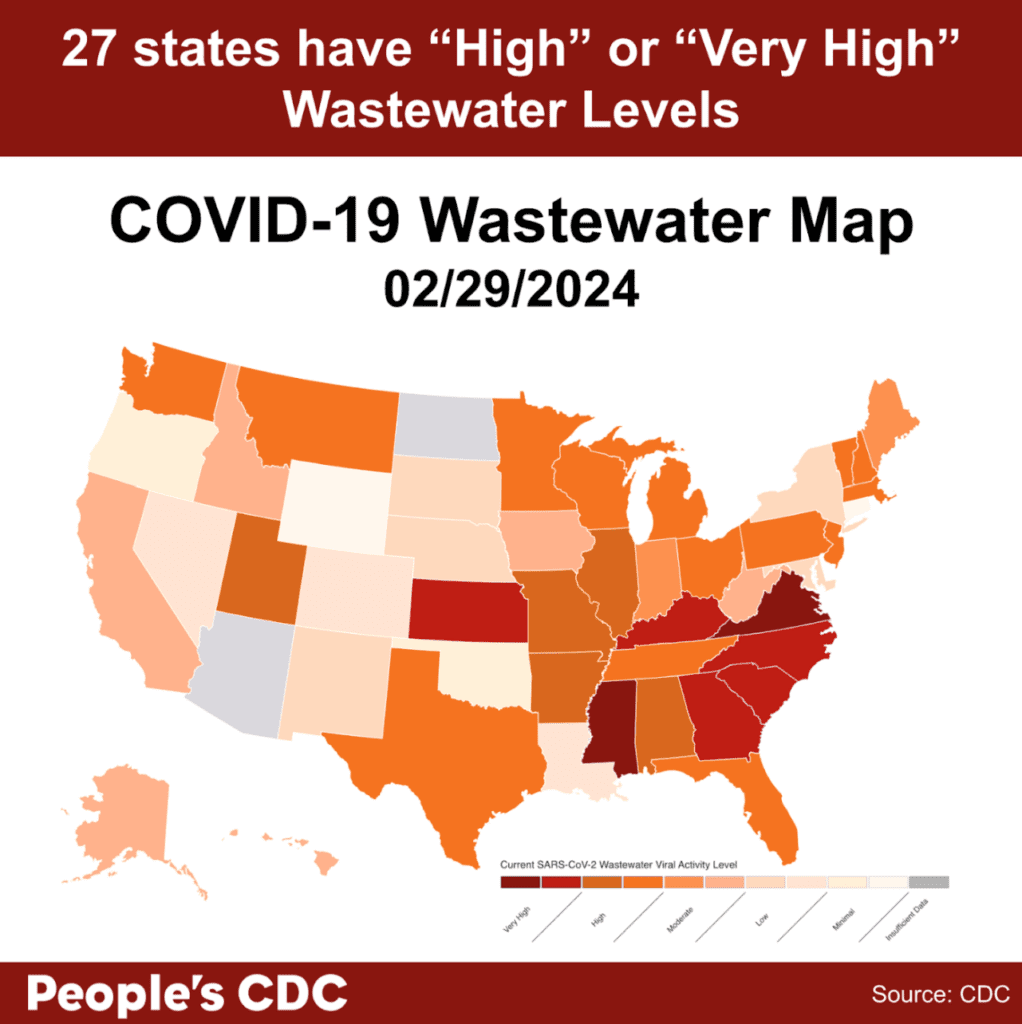The Weather
Twenty-seven US states remain at High to Very High levels of SARS-CoV-2 detected in wastewater since February 28, 2024, with five states not reporting.

Wastewater levels are decreasing throughout the country except in the Midwest. The South is still experiencing extremely high transmission. As a reminder, the last two weeks, shown in gray, are provisional data. These values may change as additional wastewater sites report data.

Despite these ongoing high levels of transmission in most of the country, and in defiance of pleas from civil society to protect the most vulnerable among us, the CDC has once again decided to walk back already insufficient protections – this time in the form of isolation guidance. It announced on Friday at 1 pm that it will repeal the 5-day isolation period for COVID-19 and instead treat COVID-19 like it does other respiratory viruses like flu and RSV, linking isolation length with symptomatology and fever. This policy, of course, is not based on the best evidence–just vibes and a lack of care for those of us still dying (1000s weekly) and still becoming disabled by Long COVID.
Last week, the CDC recommended that people 65 years and older should receive an updated booster. It did not approve a booster for other people in high-risk categories because they didn’t bother studying the benefits and risks in these groups.
Wins
OK. So it’s been a rough week. But you know what? We are all fighting back. We see you all making calls, creating and signing petitions, joining and expanding Mask Blocs, creating and distributing zines, and making your own air-cleaning systems. We see so many more masked, tested, and ventilated events than we used to! We are mobilizing collective power to keep each other safe and to transform this state.
Next week, March 11, will mark the 5th anniversary of the declaration of the pandemic. We’re not where we should be, but this pandemic has radicalized a lot of us. Keep connecting. Keep finding your people. Keep going. We will win.
Oh! And check out these Free COVID-19 and flu test vending machines in King County, Washington!
Variants
JN.1 is still the most dominant variant circulating in the United States and is projected to account for 92.3% of all circulating variants by March 2nd, 2024. Two JN.1 descendants, JN.1.13 and JN.1.18, are now the second and third most common circulating variants, projected to be at 3.3% and 1.8%, respectively.
To check for circulating variants within your community, you can find your HHS Region through the CDC Variant Tracker dashboard.

Long Covid
In an article published in Science, Drs Ziyad Al-Aly and Eric Topol reviewed the perplexing case of Long COVID. They discuss the lack of consensus and systematization when it comes to the classification of the disease, partly due to its different mechanisms and manifestations. For example, younger adult and female Long COVID patients are more likely to be afflicted by fatigue, dysautonomia, brain fog, and post-exertional malaise, while older patients are more likely to deal with cardiovascular and metabolic complications. They also discuss the current potential treatments for Long COVID, but express that since nonpharmaceutical interventions have been neglected, vaccines are the only available therapy. However, vaccines are unable to prevent Long COVID. Ultimately, they state that the only way to prevent Long COVID is by ending COVID transmission, such as by administering pan-variant neutralizing intranasal vaccines.
On March 15, 2024, the Long COVID March will be taking place in Washington D.C. at the Lincoln Memorial. The march is intended to mobilize Long COVID patients and allies to demand acknowledgment and policy changes from the government. You can read the march’s mission statement, which includes a list of objectives.
Take Action
Join us in demanding the CDC reinstate the 5-day COVID isolation policy. Despite the guidelines having already been dropped, we must still fight for adequate protections from COVID to safeguard our communities from harm. Make your voices known by sending a letter to the White House and your elected officials through our Action Network. The People’s CDC will also be implementing other action items in the coming weeks, so look out for those!
Today is COVID Memorial Day, in which we remember the 1.2 million lives lost to COVID in the United States, and show solidarity with the millions living with COVID grief and Long COVID. Check out Marked by COVID to learn more or to participate in today’s virtual vigil.
Again, we must continue to contact our elected officials to demand a ceasefire in Gaza, and we must continue to wear and require the wearing of high-quality respirators such as N95s and KN95s at protests and within organizing spaces.
Notes: 1) The numbers in this report were current as of 3/2/2024. 2) Changes in testing access as well as data reporting have led many federal data sources to become less reliable. 3) Check out the links throughout & see our website for more! https://bej.gbh.mybluehost.me. 4) Subscribe to our newsletter: People’s CDC | Substack.